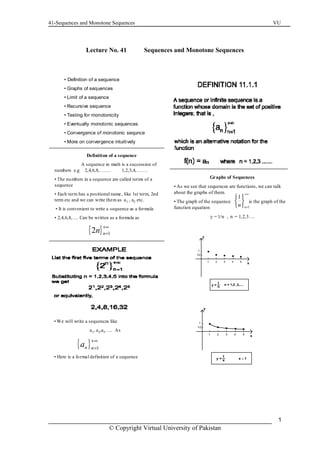
MTH101 - Calculus and Analytical Geometry- Lecture 41
- 1. 41-Sequences and Monotone Sequences VU Lecture No. 41 Sequences and Monotone Sequences © Copyright Virtual University of Pakistan 1 • Definition of a sequence • Graphs of sequences • Limit of a sequence • Recursive sequence • Testing for monotonicity • Eventually monotonic sequences • Convergence of monotonic sequnce • More on convergence intuitively Definition of a sequence A sequence in math is a succession of numbers e.g 2,4,6,8,……. 1,2,3,4,……. • The numbers in a sequence are called terms of a sequence • Each term has a positional name, like 1st term, 2nd term etc and we can write them as a1 , a2 etc. • It is convenient to write a sequence as a formula • 2,4,6,8,…. Can be written as a formula as { }+∞ =12 nn • We will write a sequences like a1, a2,a3….. As • Here is a formal definition of a sequence { }+∞ =1nna Graphs of Sequences • As we see that sequences are functions, we can talk about the graphs of them. • The graph of the sequence is the graph of the function equation y = 1/n , n = 1,2,3…. +∞ = 1 1 nn
- 2. 41-Sequences and Monotone Sequences VU © Copyright Virtual University of Pakistan 2 Limit of a sequence • Here are graphs of four sequences, each of which behaves differently as n increases • Some of these graphs have the concept of a limit in them. • A sequence an converges to a limit L if for any positive number E there is a point in the sequences after which all terms lie btw lines L+E and L-E.
- 3. 41-Sequences and Monotone Sequences VU © Copyright Virtual University of Pakistan 3 As we apply limit the following two sequences converge The following theorem shows that the familiar properties of Limits apply to sequence Recursive Sequence • Some sequences are defined by specifying one or more initial terms and giving a formula that relates each subsequent term to the term that precedes it , such sequences are said to be defined recursively . Monotonicity and testing for monotonicity
- 4. 41-Sequences and Monotone Sequences VU © Copyright Virtual University of Pakistan 4 A sequence that is either nondecreasing or nonincreasing is called monotone, and a sequence that is increasing or decreasing is called strictly monotone, but not conversely. Testing for monotonicity Monotone sequences are classified as follows Monotone Sequence with positive terms are classified as follows If f(n) = an is the nth term of a sequence, and if f is differentiable for x>=1 then we have the following results
- 5. 41-Sequences and Monotone Sequences VU © Copyright Virtual University of Pakistan 5 Eventually monotonic sequences A sequence an is eventually monotone if there is some integer N such that the sequence is monotone for n >= N Convergence of monotonic sequence
- 6. 41-Sequences and Monotone Sequences VU © Copyright Virtual University of Pakistan 6 An Intuitive View of Convergence Informally stated, the convergence or divergence of a sequence does not depend on the behavior of the “initial terms” of the sequence, but rather on the behavior of the “tail end". Thus for sequence { an } to converge to a limit L, it does not matter if the initial terms are for from L, just so the terms in the sequence are eventually arbitrarily close to L.This being the case , one can add, delete, or alter finitely many terms without affecting the convergence, divergence, or the limit (if it exists).
- 7. 41-Sequences and Monotone Sequences VU © Copyright Virtual University of Pakistan 6 An Intuitive View of Convergence Informally stated, the convergence or divergence of a sequence does not depend on the behavior of the “initial terms” of the sequence, but rather on the behavior of the “tail end". Thus for sequence { an } to converge to a limit L, it does not matter if the initial terms are for from L, just so the terms in the sequence are eventually arbitrarily close to L.This being the case , one can add, delete, or alter finitely many terms without affecting the convergence, divergence, or the limit (if it exists).
